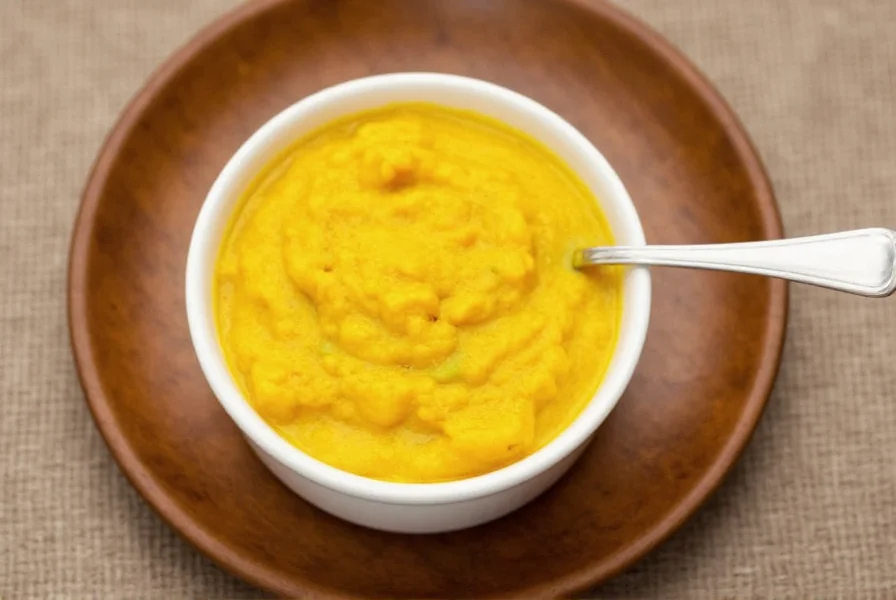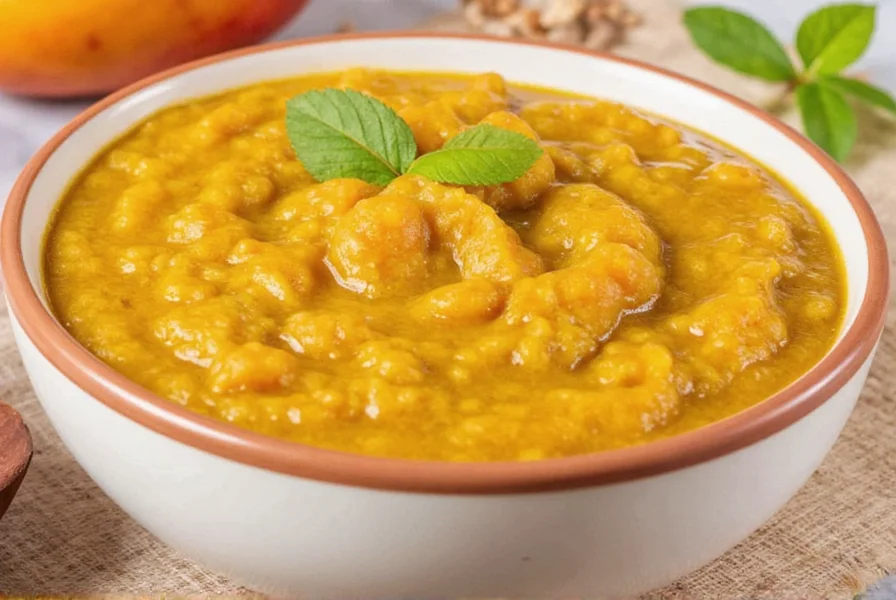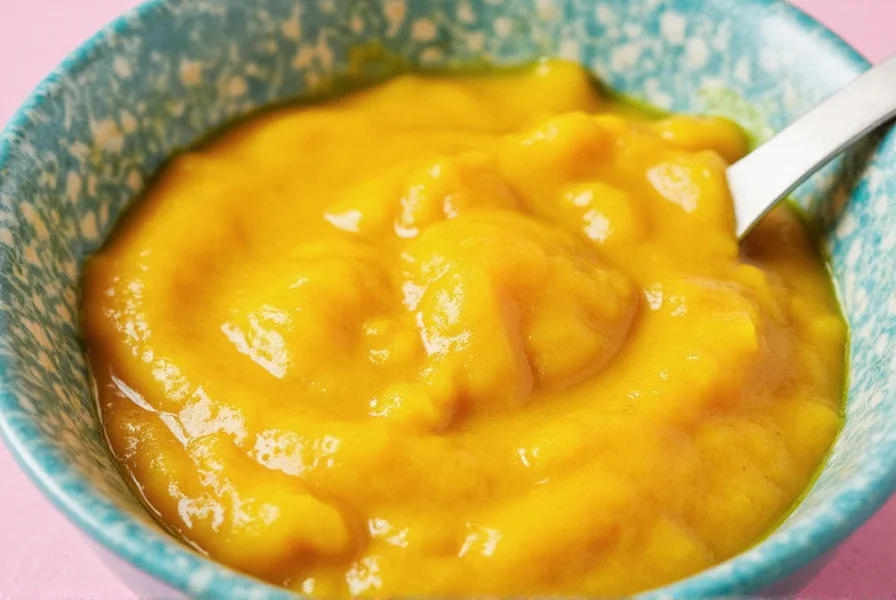Looking for a perfect mango chutney recipe? This easy homemade mango chutney recipe delivers the ideal balance of sweet, tangy, and spicy flavors in just 30 minutes. Follow these simple steps to create a delicious condiment that pairs perfectly with curries, sandwiches, and more.
Mango Chutney Recipe
Ingredients
- 2 cups green mangoes, peeled and chopped (about 2 medium mangoes)
- 1/2 cup white vinegar
- 1/2 cup brown sugar
- 1 tsp mustard seeds
- 1/2 tsp cumin seeds
- 1/2 tsp fenugreek seeds
- 1 tsp red chili powder (adjust to taste)
- 1/2 tsp turmeric powder
- 1/4 tsp asafoetida (hing)
- 1/2 tsp salt
- 1 inch fresh ginger, grated
- 2 cloves garlic, minced
- 1 tbsp water (as needed)
Instructions
- Heat a non-stick pan over medium heat. Add mustard seeds and cumin seeds. Toast until they start to pop (about 1 minute).
- Add fenugreek seeds, turmeric, red chili powder, and asafoetida. Stir for 30 seconds until fragrant.
- Add chopped mangoes, brown sugar, vinegar, salt, ginger, and garlic. Stir well to combine.
- Cook for 15-20 minutes, stirring occasionally, until the mangoes soften and the mixture thickens.
- If the mixture becomes too dry, add 1 tablespoon of water to prevent burning.
- Remove from heat and let cool completely before transferring to airtight glass jars.
- Store in refrigerator for up to 3 weeks. For longer storage, process in water bath canner for 15 minutes.
Why Mango Chutney is a Flavor Powerhouse

The beauty of mango chutney lies in its balance—sweetness from ripe or semi-ripe mangoes, acidity from vinegar or tamarind, heat from chili, and depth from warm spices. Whether used as a condiment, marinade, or glaze, a well-made chutney elevates dishes with complexity and charm.
The Core Trio: Base Ingredients for Every Chutney
Every chutney starts with a foundation. Think of these as your MVPs—the ingredients you simply cannot skip.
- Green Mangoes: The star of the show! Green mangoes bring tartness and firm texture. Ripe mangoes can be used for a sweeter version, but for classic Indian-style chutney, green mangoes are non-negotiable.
- Vinegar or Tamarind Paste: This is where the tang comes in. White vinegar is common, but apple cider vinegar adds subtle sweetness. Tamarind paste gives a richer, more complex sour note.
- Brown Sugar or Jaggery: To balance out the tartness. Jaggery offers a deeper, earthier flavor, while brown sugar is easier to work with and more widely available.
Spice It Up: Aromatic Additions That Make Magic

Now that we've got our base, let's crank up the flavor with spices. These ingredients are what give your mango chutney its soul—and they're worth getting right.
- Cumin Seeds: Toasted until fragrant, cumin seeds kick off the flavor party with their earthy warmth.
- Fenugreek Seeds: These tiny powerhouses add bitterness and umami. Use sparingly unless you want to dominate the flavor profile.
- Mustard Seeds: When popped in hot oil, mustard seeds release a nutty, pungent aroma that's unmistakably Indian.
- Red Chili Powder: Adds the necessary fire. Adjust according to taste, or substitute with fresh chopped chilies for texture and freshness.
- Turmeric: Not just for color—it also has an earthy, slightly bitter flavor that rounds out the chutney beautifully.
- Asafoetida (Hing): A pinch goes a long way. It enhances the overall spice blend without being overpowering, especially when making vegan or onion-free versions.
Flavor Boosters: The Secret Players

These ingredients might not scream "chutney," but trust us—they'll make your recipe pop like never before.
- Ginger-Garlic Paste: Adds a sharp, aromatic layer that complements both sweet and spicy elements.
- Salt: Essential for balancing flavors. Use coarse sea salt for texture or pink Himalayan for trace minerals.
- Raisins or Dried Apricots: For natural sweetness and chewiness. They mimic the raisin-like effect found in some traditional recipes.
- Cashews or Almonds: Ground into a paste, they thicken the chutney and add a creamy mouthfeel.
- Jalapeños or Bell Peppers: For those who like a little crunch or prefer milder notes alongside heat.
- Lime Juice: Brightens the final product. Best added at the end to preserve freshness.
Essential Tools for Chutney Success

While ingredients are king, having the right tools helps ensure consistent, restaurant-quality results every time.
- Non-Stick Pan: Prevents burning and sticking, which can ruin delicate flavors.
- Blender or Food Processor: For achieving smooth texture or chunky consistency depending on your style.
- Airtight Glass Jars: Store your chutney safely and keep it fresh longer. Glass preserves flavor better than plastic.
- Mortar and Pestle: If grinding whole spices by hand, nothing beats the authenticity of mortar and pestle.
Buying Guide: What to Look For When Shopping

Shopping for the right ingredients can be overwhelming, especially if you're new to spice-heavy cooking. Here's a quick guide to help you pick the best options:
| Ingredient | What to Look For | Best Brands / Varieties | Use Case |
|---|---|---|---|
| Raw Mangoes | Firm, unblemished skin; avoid soft or mushy ones | Ataulfo (small & tart), Tommy Atkins (larger, fibrous) | Classic tangy chutney |
| Brown Sugar | Soft, moist texture with rich molasses scent | Wholesome Organic, Domino | Balancing tartness |
| Mustard Seeds | Whole, unbroken seeds with strong smell | Kalonji (Nigella), Yellow Mustard Seeds | Tadka (tempering) base |
| Tamarind Paste | Thick, dark brown paste with no additives | MTR, Badia, Homemade Block | Deep, rich sourness |
| Cumin Seeds | Uniform size, light brown color, aromatic | Spice Garden, Simply Organic | Main spice layer |
| Asafoetida | Powdered form preferred, packed tightly | Himalaya Naturals, Everest | Vegan-friendly enhancer |
Specialized Picks for Unique Flavors
If you're looking to elevate your chutney game further, consider these niche products:
- Kala Namak (Black Salt): For a sulfurous, egg-like depth—ideal for vegan 'cheesy' twists.
- Panch Phoron: A five-spice Bengali blend great for tadka. Includes fenugreek, nigella, cumin, fennel, and mustard seeds.
- Mango Powder (Amchur): Adds acidity without moisture—useful for dry chutney powders or rubs.
Conclusion: Your Perfect Batch Starts Here

Whether you're a seasoned cook or a curious foodie, mastering the art of mango chutney opens up a world of culinary possibilities. From basic ingredients like green mangoes and vinegar to spice blends and hidden flavor boosters, each element plays a unique role in creating a balanced, unforgettable taste experience.
Frequently Asked Questions About Mango Chutney Ingredients
What are the 5 most essential ingredients for perfect mango chutney?
The five most essential ingredients for perfect mango chutney are: 1) Green mangoes (for tartness), 2) Vinegar or tamarind (for acidity), 3) Jaggery or brown sugar (for sweetness), 4) Mustard seeds (for that distinctive pop and nuttiness), and 5) Red chili powder (for heat). These form the foundation of flavor balance that defines great mango chutney.
Can I use ripe mangoes instead of green mangoes for chutney?
Yes, but it will create a very different product. Ripe mangoes produce a sweeter, less tangy chutney with softer texture. Traditional Indian mango chutney relies on green mangoes for their tartness and firm structure. If using ripe mangoes, you'll need to significantly increase the vinegar/tamarind and reduce the sugar to maintain proper flavor balance.
How do I fix mango chutney that's too sweet?
If your chutney is too sweet, add acidity to balance it. Start with 1-2 teaspoons of vinegar or lemon juice and simmer for 5-10 minutes. You can also add a pinch of salt to counteract sweetness. For more complex balancing, try adding a small amount of tamarind paste or even a few drops of hot sauce. Remember to adjust in small increments and taste as you go.
How long does homemade mango chutney last?
Properly prepared and stored in airtight glass jars, homemade mango chutney lasts 2-3 weeks in the refrigerator. For longer storage (up to 6 months), process the jars in a water bath canner. The vinegar content acts as a natural preservative. Always use clean utensils when serving to prevent contamination that could shorten shelf life.
What can I substitute for tamarind in mango chutney?
If you don't have tamarind, good substitutes include: 1) Lemon or lime juice (use 2:1 ratio as it's more acidic), 2) Amchoor (mango powder), 3) White vinegar with a pinch of sugar, or 4) Pomegranate molasses for a similar sweet-tart profile. Each substitute will create a slightly different flavor, so choose based on what complements your other ingredients.
Why is my mango chutney too watery and how can I fix it?
Mango chutney can become watery if the mangoes release too much liquid or if insufficient cooking time is allowed for evaporation. To fix watery chutney, continue simmering on medium-low heat until it reaches your desired consistency. You can also make a slurry with 1 teaspoon cornstarch mixed with 2 teaspoons cold water, then stir it into the chutney and cook for 2-3 minutes until thickened. Remember that chutney will continue to thicken as it cools.
Can I make mango chutney without sugar?
Yes, you can make mango chutney without traditional sugar. Good alternatives include honey, maple syrup, coconut sugar, or even dates for natural sweetness. Some recipes use grated apple or carrots to add natural sugars. Keep in mind that sugar isn't just for sweetness—it helps preserve the chutney and balances the acidity. When substituting, you may need to adjust vinegar amounts and expect a slightly different texture and shelf life.











 浙公网安备
33010002000092号
浙公网安备
33010002000092号 浙B2-20120091-4
浙B2-20120091-4